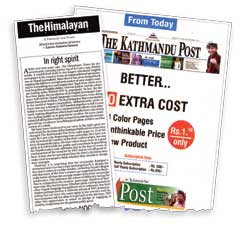 The recent selling of two daily newspapers-The Himalayan Times (THT) and Annapurna Post-in a lower price than any other daily newspapers.in the country is probably with predatory intent." So went a line from an op-ed in The Kathmandu Post (TKP) on 21 December. Three weeks later, TKP slashed its newsstand price by 62 percent down to only Rs1.50 per copy (and 42 paisa per copy for subscribers of its sister publication Kantipur national daily). Overnight, TKP made itself the lowest-priced English daily broadsheet in Nepal, with contents that have long been available for free on the Internet.
The recent selling of two daily newspapers-The Himalayan Times (THT) and Annapurna Post-in a lower price than any other daily newspapers.in the country is probably with predatory intent." So went a line from an op-ed in The Kathmandu Post (TKP) on 21 December. Three weeks later, TKP slashed its newsstand price by 62 percent down to only Rs1.50 per copy (and 42 paisa per copy for subscribers of its sister publication Kantipur national daily). Overnight, TKP made itself the lowest-priced English daily broadsheet in Nepal, with contents that have long been available for free on the Internet. Though Kantipur Publications, publishers of the The Kathmandu Post, loftily explained that change in terms of how a lower priced newspaper could benefit students learning English, talk has it that the gains made by the rival THT (at Rs 2 per copy) in the last two years was too disturbing for TKP to tolerate. And so, it had no choice but to engage in some kind of a price war.
But is that all there is to this story? Wouldn't it be incomplete to view this price war only through a "TKP versus THT" lens, especially given that Nepali media houses' orbits are bigger in that they publish both English and Nepali newspapers? Instead, could it be that TKP publishers are trying to position their paper as a lower-level niche player that could be used further as a marketing tool to shore up their flagship product Kantipur's lead?
A daily newspaper is driven by sales-of printed copies and print space. Regular buyers tend to be loyal to the papers they read habitually and are reluctant to switch to another newspaper. But advertisers tend to be fickle. The marketing department has to continuously court them by waving large circulation numbers. In theory, by slashing its subscription charge, a newspaper can increase both newsstand sales and the number of subscribers, and then use that information to attract big-paying advertisers. But, as similar examples from around the world show, engaging in a price war just for the sake of making your rival blink may give you an ego boost in the short run, but will not necessarily increase your net profits. That's because any additional revenue will have to be plowed back into publicity, personnel, rent and news-gathering resources.
In Nepal, despite facing an increasing competition for advertisement rupees in all forms of media in recent years, Kantipur Publications' biggest money-spinner remains the decade-old Kantipur. Even its rivals agree that Kantipur has a sizeable base of subscribers whose demonstrated presence encourages advertisers to place their messages-even if it means that at times the newspaper looks like a catalogue!
Needless to say, most advertisers are based in Kathmandu and other urban towns. Given such a scenario, it makes no sense for TKP alone to go head-to-head with THT and drain resources. But it makes sense for Kantipur Publications as a whole to have TKP piggy-back on Kantipur's existing strengths to: a) steal some of THT's market share, b) reposition TKP as a jazzier lower-level English-language product with a city focus and c) then use the combined increased circulation numbers to make new deals with advertisers to rope in money.
If you look at it this way, this is more like a weaker brother and a stronger brother hanging tight against a common rival as opposed to only the weaker brother fighting the fight.



